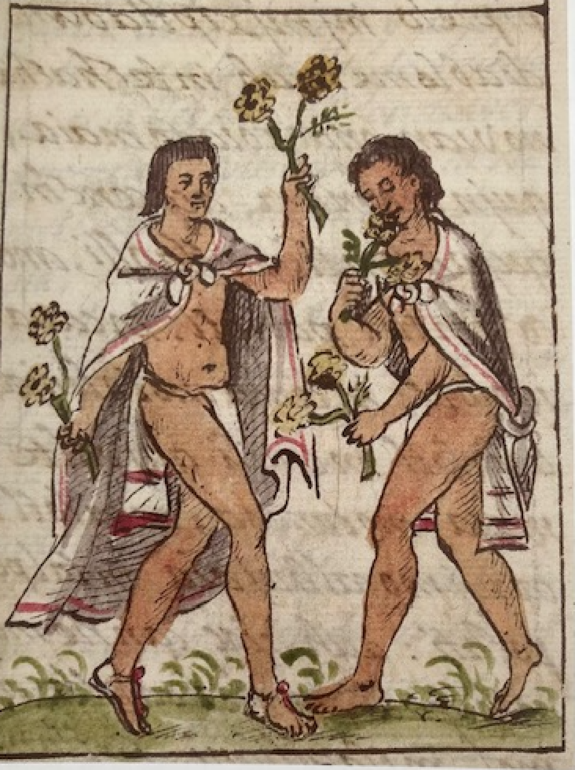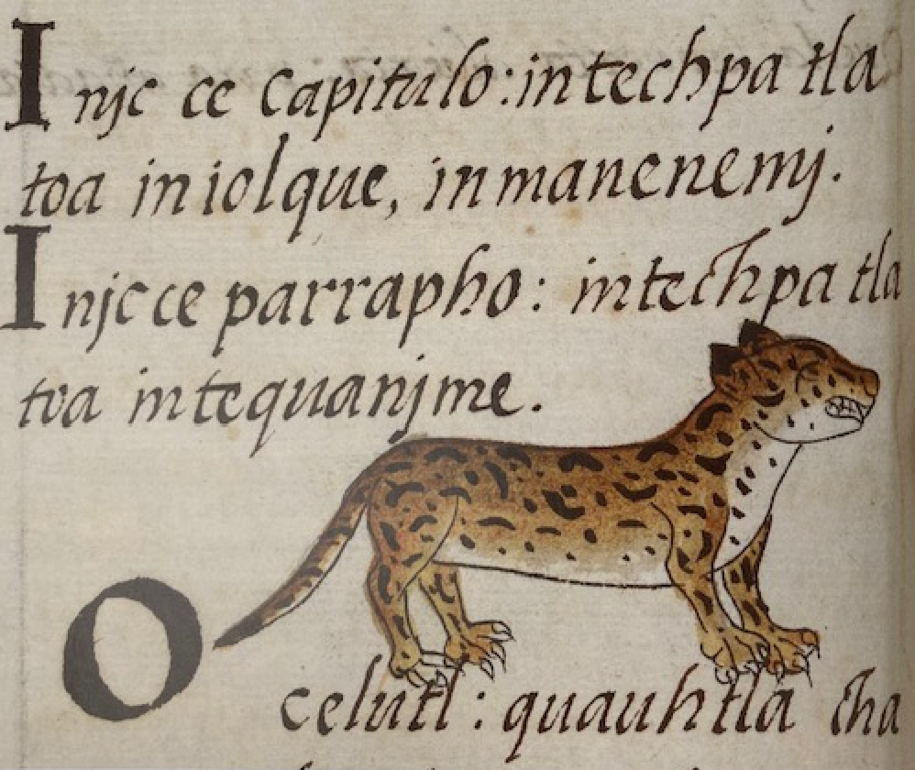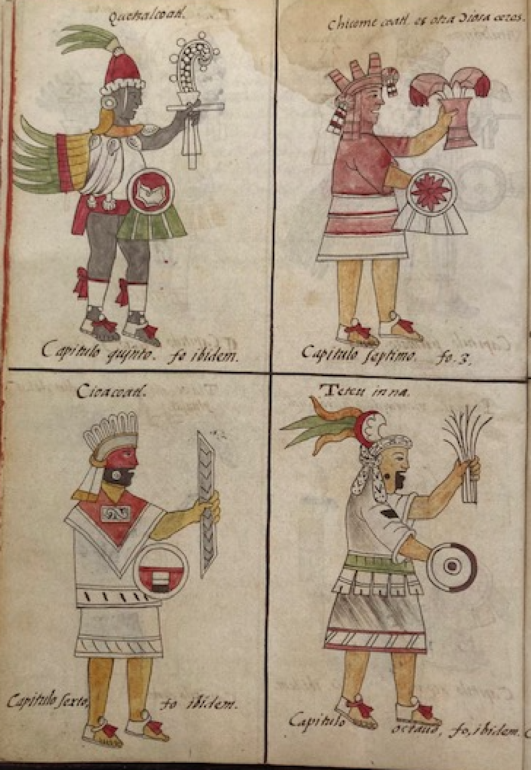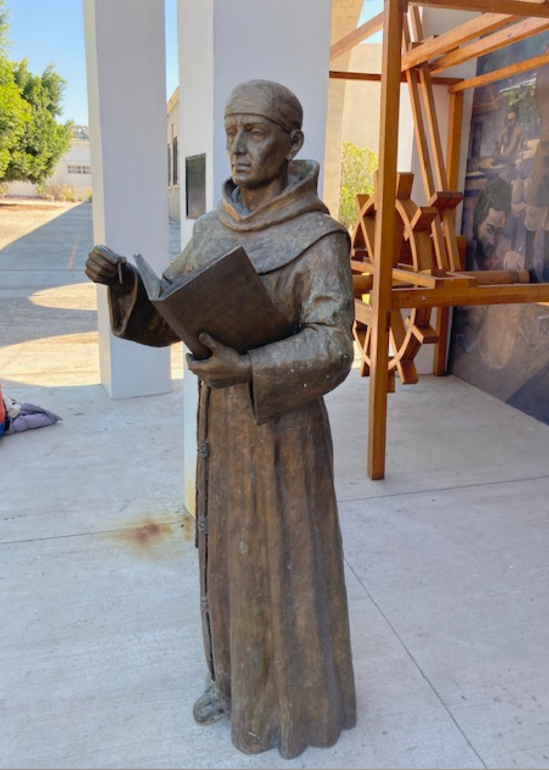
Contemporary artist's rendition of Sahagún's scriptorium
*
Español
February 11, 2024
by Philip Gambone
During the 16th century, a Franciscan friar, Bernadino de Sahagún, working with a team of Indigenous Mexican artists and scribes, compiled a remarkable encyclopedia on the history and culture of the Nahua (Aztecs). Called Historia general de las cosas de Nueva España (General History of the Things of New Spain), the book represents an extraordinary achievement. "The most remarkable and most important intellectual product of the exchange between Indigenous and European cultures in the early modern Atlantic world," writes Kevin Terraciano, the director of the Latin American Institute at UCLA.
Sahagún was a Spanish Franciscan missionary, who came to New Spain in 1529, when he was in his late twenties. He spent the next 50 years in Mexico learning Nahuatl and studying and recording Aztec culture, "projects that stand out for their originality and sheer ambition," says Terraciano. Indeed, Sahagún's efforts to preserve Nahua culture and language distinguish him as the Western world's "first anthropologist."

Decoration of altars (Book 2)
*
Around 1547, with the help of a small team of Nahua collaborators, Sahagún began to record the "words of the ancients" (huehuetlatolli), transcribing their language with the Roman alphabet. He and his Nahua collaborators were out to "record the memories of a preconquest past," writes Jeanette Favrot Peterson, another scholar of pre-Columbian and colonial Latin America.
Sahagún's work met with criticism from some of his fellow Franciscans, who wondered if recording Indigenous culture ran contrary to their goal of converting the natives to Christianity. His books were confiscated and sent to other monks for their evaluation. Happily, Sahagún was eventually able to retrieve his work.
More happily still, the Franciscan provincial in New Spain commissioned him to expand his project. Consequently, Sahagún undertook a deeper and more systematic approach to recording Nahua culture. He began to interview elders, asking them about "divine or more precisely idolatrous things, and human and natural [things]."

Ocelot (Book 11)
*
Sahagún set up a scriptorium in the Colegio de Santa Cruz in Santiago Tlatelolco, the first European college in the Americas. There he not only undertook to compile a compendium of the Nahua language—a book Sahagún deemed "a treasury for the knowledge of many things worthy of being known"— but also engaged in recording an extensive archive of information about the Nahua world.
Sahagún acted as coordinator, compiler, editor and translator of the project. His Nahua assistants presented him with paintings, the form of writing the Nahua used. These assistants then described those paintings in their language. Again, using the Roman alphabet, Sahagún transcribed the words his assistants spoke as they "read" the old codices.

Spaniard beheads Mexica (Book 12)
*
In addition to all his other roles, Sahagún had to keep everyone's spirits up, because a smallpox epidemic broke out in 1576, killing off some of his team. Then in his seventies, he had already witnessed the Indigenous people decimated by disease and conquest. Now with the outbreak of this new epidemic, he feared the utter eradication of the Nahua and their culture.
Sahagún prevailed, producing a bi-lingual, profusely illustrated (muy historiado, he said) copy of his encyclopedia, which he finished in the spring of 1577. It was a work, Sahagún wrote, "worthy of being contemplated by a king." That dream was realized when, about 1580, another Franciscan, Fray Rodrigo Sequera, took the Historia general de las cosas de Nueva España—all 2,446 pages of it—to the royal court in Spain. Within a decade, the Codex ended up in the Medici library in Florence (hence the name "Florentine Codex"), where it lay virtually forgotten for centuries.

The Gods (Book 1)
*
Sahagún compiled the vast amount of material he collected into twelve books organized along a hierarchical scheme. The first seven books address the divine world of the Nahua. The next three books turn to the human world: kings, lords, and governance (Book 8); merchants and artisans (Book 9); the people and anatomy (Book 10). Sahagún's extraordinary compendium concludes with a book on nature and animals (the longest and most profusely illustrated); and, in Book 12, a history of the conquest of Nueva España.
According to Guilhem Olivier, another scholar of the Codex, "the gods stirred the friar's greatest interest and were the topic to which he devoted the most space." Nevertheless, as a good Franciscan, Sahagún was aware of the potential that images of the Nahuas' gods carried for promoting idolatry. In Book 1 ("Gods"), for example, he inveighed against the Indians' false gods, which were, he wrote, only "carvings of stone, carvings of wood, representations, images." While the Florentine Codex abounds in images of such "idolatry," Sahagún attempted to diminish the potential these illustrations had by including interpolations that criticized the "wretched idolaters."

Teotl (deity) being venerated (Book 1)
*
The Codex is actually written in three "texts": Nahuatl, Spanish, and in copious illustrations, most of them in color. The Indigenous painters (tlacuiloque) employed both European artistic principles and preconquest pictorial traditions to create a kind of "mestizo or hybrid art. "It is the images," writes Peterson, "that betray the most striking intermingling of the indigenous and the European ways of knowing and seeing." What we have here are Nahua artists at work, at once preserving the past of their culture and "position[ing] themselves within a new world order." These artists, "kept a native readership in mind" and thus were able to retain "a plurality of voices."

Omens presaging the Conquest (Book 8)
*
Another one of the many stunning images in the Codex (from Book 8: "Kings, Lords, Governance") depicts three omens that presaged the Spanish conquest of the Aztec kingdom. The first imnage, at the top, shows a "singing building" with a sound scroll emanating from an architectural beam. Moving counterclockwise, the next omen shows a wailing Serpent Woman; the third omen depicts a prone woman, who had died and was resuscitated so that she could predict the fall of Montezuma's reign.
"The Florentine Codex is singular in that the end product relied on the constant participation of Nahua scholars," Terraciano writes. "The dynamic process of exchange and interaction between Sahagún and his team of Nahuas created new forms of expression and knowledge. The final product is truly unique."

Plants (Book 11)
*
Readers interested in more information about the Florentine Codex might want to start with the superbly written and illustrated volume put out by the University of Texas Press, The Florentine Codex: An Encyclopedia of the Nahua World in Sixteenth-Century Mexico (2019), edited by Jeanette Favrot Peterson and Kevin Terraciano.
For someone like me, interested in all aspects of "The Writer in Mexico," this book handsomely and intelligently underscores the message that the literary culture of Mexico enjoys a long and complex history.

Statue of Sahagún on Calle Stirling Dickinson
*
**************

Philip Gambone, a retired high school English teacher, also taught creative and expository writing at Harvard for twenty-eight years. He is the author of five books, most recently As Far As I Can Tell: Finding My Father in World War II, which was named one of the Best Books of 2020 by the Boston Globe. He will be doing a reading from that book at the San Miguel Writers' Conference on Tuesday, February 20.
**************
*****
Please contribute to Lokkal,
SMA's online collective:
 ***
***
Discover Lokkal:
Watch the two-minute video below.
Then, just below that, scroll down SMA's Community Wall.
Mission

Visit SMA's Social Network
Contact / Contactar

